Production and Craftsmanship
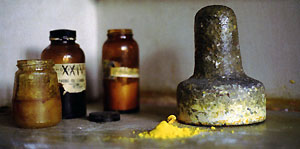 Still in Paris, Egon von Vietinghoff recognized that he could not realize his world of colors and gratify his artistic demands with industrial, premade paints. His transcendental approach required a technique which was attainable only with the most natural and carefully selected and prepared materials possible. When painting with this technique, many of the ready-to-use oil paints in tubes are not adequate as they do not contain enough pigments, are stretched and too fat, darken or become dull after a while. To be an artist means to be a craftsman as well and Vietinghoff spent more than half of his time in the preparation of his materials only!
Still in Paris, Egon von Vietinghoff recognized that he could not realize his world of colors and gratify his artistic demands with industrial, premade paints. His transcendental approach required a technique which was attainable only with the most natural and carefully selected and prepared materials possible. When painting with this technique, many of the ready-to-use oil paints in tubes are not adequate as they do not contain enough pigments, are stretched and too fat, darken or become dull after a while. To be an artist means to be a craftsman as well and Vietinghoff spent more than half of his time in the preparation of his materials only! 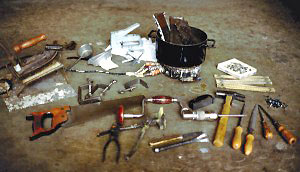 In his studio, he produced his paints from the most pure pigments and his binders from natural, raw materials. They are the reason for the naturalness and inner luminosity of his distinctive paintings. Thus from time to time, his contemplative studio turned into a real workshop. He boiled used old tablecloths and bed sheets because new linen is impregnated, hard and easily creased. After cutting them in appropriate sizes, he had to iron them and fix on a wooden stretcher frame, ready to be spread with glue, before applying up to seven layers of the base. If he did not stretch the canvas, he stuck it on a board which he sawed from large panels.
In his studio, he produced his paints from the most pure pigments and his binders from natural, raw materials. They are the reason for the naturalness and inner luminosity of his distinctive paintings. Thus from time to time, his contemplative studio turned into a real workshop. He boiled used old tablecloths and bed sheets because new linen is impregnated, hard and easily creased. After cutting them in appropriate sizes, he had to iron them and fix on a wooden stretcher frame, ready to be spread with glue, before applying up to seven layers of the base. If he did not stretch the canvas, he stuck it on a board which he sawed from large panels. 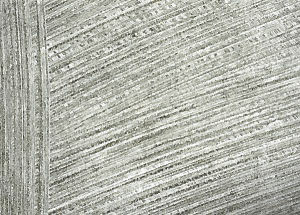 This process alone needed twelve days, including the drying times between the various base layers. He used these waiting periods to produce the needed solvents and binders which he composed of different oils, resins, wax and emulsions. Also, he mixed the purchased pigments and the self-produced binders, moving with both hands a heavy stone on a glass pane in order to get homogeneous paints.
This process alone needed twelve days, including the drying times between the various base layers. He used these waiting periods to produce the needed solvents and binders which he composed of different oils, resins, wax and emulsions. Also, he mixed the purchased pigments and the self-produced binders, moving with both hands a heavy stone on a glass pane in order to get homogeneous paints. 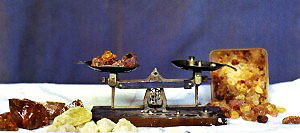 After this, while standing and sweating for hours, he filled the fresh paint into tubes or small glasses. These often strenuous activities brought a temporary change to his sedentary way of working and kept him fit for a long time.
After this, while standing and sweating for hours, he filled the fresh paint into tubes or small glasses. These often strenuous activities brought a temporary change to his sedentary way of working and kept him fit for a long time. 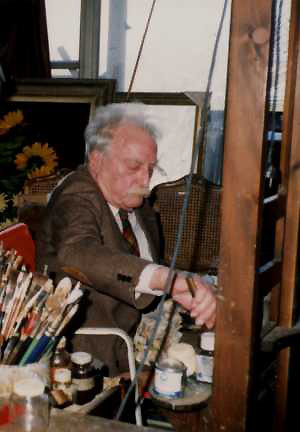 As we saw, Vietinghoff executed every single step of the preparation himself, from the beginning until the end, so he could envision the impact of the materials to the overall impression of a future painting even in the developmental stage. He knew in advance the ratio of a certain yellow, which he would need to paint cherries bought at the market one week later, or to paint a flower bouquet found by his wife, Liane, on one of her many walks.
As we saw, Vietinghoff executed every single step of the preparation himself, from the beginning until the end, so he could envision the impact of the materials to the overall impression of a future painting even in the developmental stage. He knew in advance the ratio of a certain yellow, which he would need to paint cherries bought at the market one week later, or to paint a flower bouquet found by his wife, Liane, on one of her many walks. For the shade of yellow of a lemon or fried egg, the ratio perhaps had to be different as he would paint these in winter time when domestic fruit and natural flowers were not available. Also, the consistency of the paint should be different to tone a larger surface than for a precise light reflection, and a translucent brush stroke different from an opaque, pastose or dry one.
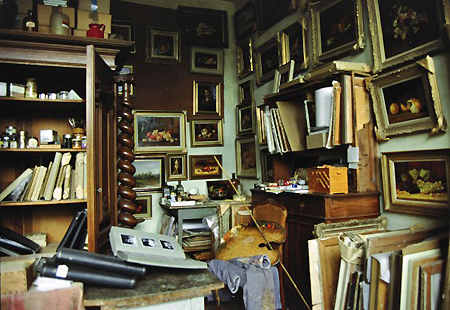 Over 5 decades, Vietinghoff recorded his continual material experiments and painting experiences until he published all his findings at the age of 80 in the "Manual of Painting Technique" (only in German).
Over 5 decades, Vietinghoff recorded his continual material experiments and painting experiences until he published all his findings at the age of 80 in the "Manual of Painting Technique" (only in German). 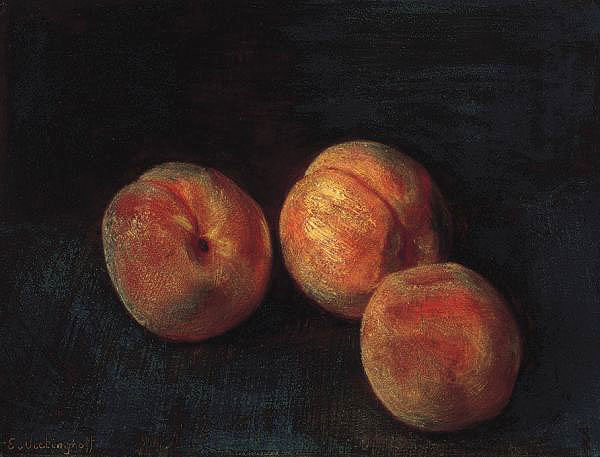 The interaction of the self-manufactured paints and its experienced application leads to a creation through purely the means of color without the aid of relief, collage and vanishing point. Egon von Vietinghoff executed pure painting without elements from other genres of art such as inserted poems and multi-media.
The interaction of the self-manufactured paints and its experienced application leads to a creation through purely the means of color without the aid of relief, collage and vanishing point. Egon von Vietinghoff executed pure painting without elements from other genres of art such as inserted poems and multi-media.